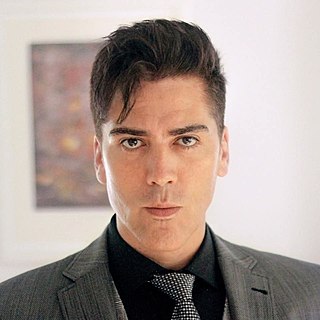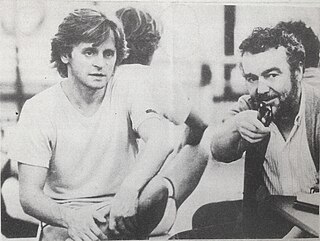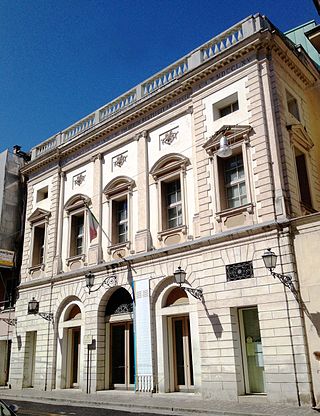
Modena is a city and comune (municipality) on the south side of the Po Valley, in the Province of Modena in the Emilia-Romagna region of northern Italy.

Luciano Pavarotti was an Italian operatic tenor who during the late part of his career crossed over into popular music, eventually becoming one of the most acclaimed tenors of all time. He made numerous recordings of complete operas and individual arias, gaining worldwide fame for his tone, and gaining the nickname "King of the High Cs".

The Teatro Comunale di Bologna is an opera house in Bologna, Italy. Typically, it presents eight operas with six performances during its November to April season.
Correggio is a town and comune in the Province of Reggio Emilia, in the Emilia-Romagna region of Italy, in the Po valley. As of 31 October 2022 Correggio had an estimated population of 25,076.

The Music of Emilia-Romagna has the reputation of being one of the richest in Europe; there are six music conservatories alone in the region, and the sheer number of other musical venues and activities is astounding. The region, as the name implies, combines the traditions of two different, contiguous areas—Emilia and Romagna—and it is perhaps this blend that contributes to the wealth of musical culture.

The Teatro Comunale in Ferrara is an opera house, located in the Italian region of Emilia-Romagna, and built between 1786 and 1797 with seating for 990. Privately owned theatres with limited seating capacity had existed in the city for many years, but the arrival of Cardinal Spinelli, the new papal envoy, in 1786 spurred the construction of a new public theatre under the architects Cosimo Morelli and Antonio Foschini. However, their disagreements led to conflicting design concepts regarding the elliptical shape of the auditorium which were resolved through compromise. The theatre was finally ready for its inaugural presentation of Portogallo's Gli Orazi e i Curiazi on 2 September 1798.

Clorinda Corradi was an Italian opera singer and one of the most famous contraltos in history.
Géraldine Chauvet is a French operatic mezzo-soprano.

Mexican tenor Jesús León is one of the most acclaimed ‘bel canto’ tenors of his generation. His vocal studies began with the Cuban tenor Jesús Li, followed by attendance at the UCLA Opera Studio, the Solti Accademia di Bel Canto, the Boston University Opera Institute and the Domingo-Thornton Young Artist Program at Los Angeles Opera. He also trained in Italy under the direction of legendary soprano Mirella Freni, who granted him the Nicolai Ghiaurov scholarship.
Arrigo Pola was an Italian tenor who had an active international performance career during the 1940s through the 1960s. After, he embarked on a second career, as a celebrated voice teacher in both Italy and Japan. Among his notable pupils were tenors Luciano Pavarotti, Giuliano Bernardi, Vincenzo La Scola and bass Michele Pertusi. He also served as the Artistic Director of the Fujiwara Opera from 1957 to 1965.

Giancarlo Monsalve Leyton is a Chilean spinto tenor. He is the Cultural Ambassador of his home town Valparaíso, a UNESCO World Heritage site. He is known for his portrayal as Don José in Carmen, Cavaradossi in Tosca, Turiddu in Cavalleria rusticana, the title role in Don Carlos, Riccardo in Un ballo in maschera, Prince Calaf in Turandot and Don Alvaro in La forza del destino
Lorenzo Mariani is a stage director of opera in Italy, the United States, Israel, Finland, and across the world. From 2005 to 2012 Mariani has been artistic director of the Teatro Massimo in Palermo. The Teatro Massimo is the largest theatre in Italy.

Javid Samadov is an Azerbaijani baritone opera singer, who currently resides in Nuremberg, Germany.

PierLuigi Samaritani was a renowned opera director/production designer, who began his career at a young age, working alongside some of the greatest names in theatre, opera and ballet, such as Lila de Nobili, Giancarlo Menotti, Franco Zeffirelli, Luciano Pavarotti, Mikhail Baryshnikov, Rudolf Nureyev and many more. Samaritani had an enormous talent, which allowed him to take on all the roles the theatre, opera and ballet demanded, making sure to always be involved in all aspects of his productions even when delegating. From the creation of his "sketches" of the set, which were more like works of art in and of themselves to the smallest change in an extra’s costume, he was a true perfectionist preoccupied with every detail. His productions graced the stage of countless opera houses and theaters, amongst them La Scala di Milano, Teatro Regio of Parma, The Metropolitan Opera House, American Ballet Theatre and the Festival of Two Worlds at Spoleto, where he collaborated for many years, alongside his dear friend, Gian Carlo Menotti. The Teatro Lirico Sperimentale di Spoleto founded in 1947 in Spoleto, by Adriano Belli created a special award carrying the name of Pier Luigi Samaritani, awarded each year to the set designer with the best set design of the opera season.
Luigi Manzini (1805–1866) was an Italian painter of the Neoclassic and Romantic periods, active mainly in and around his native Modena.
The following is a timeline of the history of the city of Treviso in the Veneto region of Italy.
Massimo Carpegna is an Italian conductor.
Michele Mariotti, born in 1979 in Urbino, near Pesaro, is an Italian conductor, the direttore musicale since 2014 of Teatro Comunale di Bologna. A graduate in composition of Pesaro's Conservatorio Rossini, where he also studied orchestral conducting, he made his professional opera debut with Il barbiere di Siviglia in Salerno on Oct. 12, 2005. As of April 2017, his repertory included nine Rossini and eight Verdi operas, an extraordinary achievement, as well as symphonies of Beethoven, Bruckner and Schubert, the Rossini Stabat mater, the Mozart Requiem and the Verdi Requiem.

The Teatro Mario Del Monaco is an opera house and theatre in Treviso, Italy. It was previously known as the Teatro Onigo from 1692 to 1846, the Teatro Sociale from 1847 to 1930, and the Teatro Comunale from 1931 to 2011. In 2011, it was renamed in honour of the Italian tenor Mario Del Monaco who lived in Treviso from 1975 until his death in 1982. It is located in the historic centre of the city on the Corso del Popolo and since 2019 has been run by the Teatro Stabile del Veneto which also runs the Teatro Goldoni in Venice and the Teatro Verdi in Padua.












